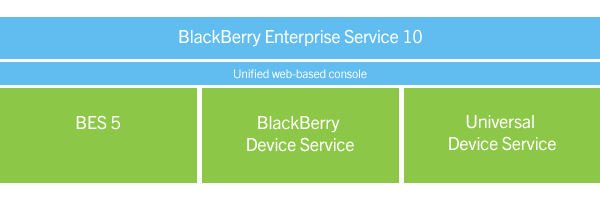
RIM outlined today its intentions for BlackBerry Enterprise Service 10, the future consolidated name for what we understand today as BlackBerry Mobile Fusion and BES 5.3. A few weeks ago we told you that BES 10 would, and then wouldn’t, be able to accomodate BB7 and older legacy devices, and RIM’s blog post clears up all of those concerns.
When BlackBerry Enterprise Service 10 comes out, presumably in conjunction with BB10 devices in early 2013, BES 5 will need to be installed on a separate server in order to manage legacy devices. The BlackBerry Device Service (BDS) and Universal Device Service (UDS) are the two components that comprise administrative control of BB10 and PlayBook, and iOS and Android respectively. Those names, along with BES 5, will be consolidated under the BES 10 name in marketing, branding and product announcements going forward.
What is BlackBerry Enterprise Service 10?
BlackBerry Enterprise Service 10 represents a consolidation of our enterprise mobility management (EMM) product portfolio, which includes our mobile device management (MDM), security, infrastructure, and app management products. It will prepare your organization for the future of mobile diversity, as well as integrate with your existing BlackBerry Enterprise Server (BES) deployment. From a single unified web-based console, BES 10 will manage the following devices:
– BlackBerry 7 OS and prior smartphones
– BlackBerry 10 devices
– BlackBerry PlayBook tablets
– iOS and Android™ smartphones and tabletsBES 10 will be the ultimate management solution for all BlackBerry platform devices, as well as iOS and Android devices. BES 10 will launch with the first BlackBerry 10 devices in Q1 of calendar year 2013.
RIM remains committed to our enterprise customers by providing advanced, innovative, and flexible options for a straight-forward migration to BlackBerry 10 smartphones, as well as cross-platform management of your mobile device deployment.
What will the components and requirements be for BES 10?
BlackBerry Enterprise Service 10 will be a complete solution that includes several components to manage multiple smartphones and tablets. Management occurs through a single, unified web-based administration console that will provide one place to manage all of the devices listed above.
In addition to the unified management console, the components of BES 10 will initially include current products already in market:
– BlackBerry® Device Service (BDS) – supporting BlackBerry PlayBook tablets and BlackBerry 10 smartphones when they launch in Q1 2013 through the use of Microsoft ActiveSync for email and PIM synchronization
– Universal Device Service (UDS) – providing Enterprise Mobility Management functions for iOS and Android devices
– Integration with existing BlackBerry Enterprise Server (BES) 5.0.3 and above
RIM plans to upgrade BES 10 after its initial release to allow BES 5 to operate on the same physical server as BES 10, which at that time will consolidate the once-disparate BDS and UDS components into one product.
There’s a lot of great information for server admins in the post, so take a look.
Source: BlackBerry Business Blog


